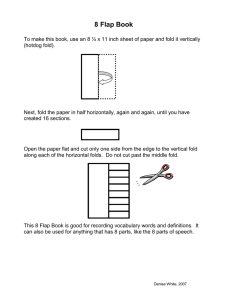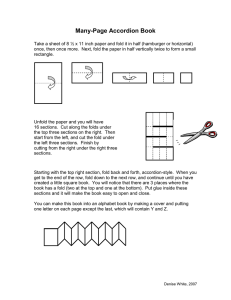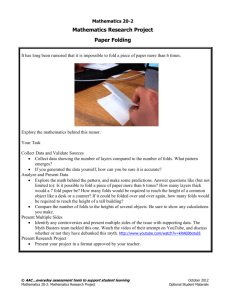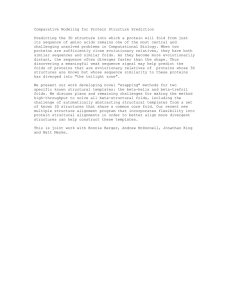GY 111 Lecture Notes Folds Lecture Goals
advertisement
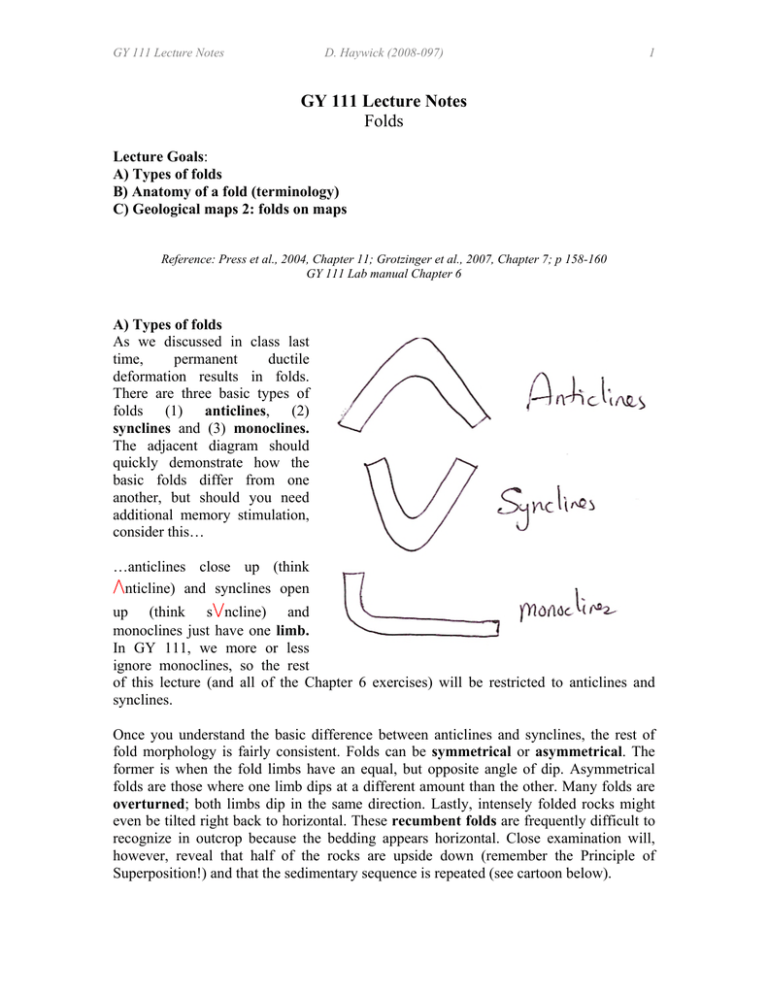
GY 111 Lecture Notes D. Haywick (2008-097) 1 GY 111 Lecture Notes Folds Lecture Goals: A) Types of folds B) Anatomy of a fold (terminology) C) Geological maps 2: folds on maps Reference: Press et al., 2004, Chapter 11; Grotzinger et al., 2007, Chapter 7; p 158-160 GY 111 Lab manual Chapter 6 A) Types of folds As we discussed in class last time, permanent ductile deformation results in folds. There are three basic types of folds (1) anticlines, (2) synclines and (3) monoclines. The adjacent diagram should quickly demonstrate how the basic folds differ from one another, but should you need additional memory stimulation, consider this… …anticlines close up (think vnticline) and synclines open up (think swncline) and monoclines just have one limb. In GY 111, we more or less ignore monoclines, so the rest of this lecture (and all of the Chapter 6 exercises) will be restricted to anticlines and synclines. Once you understand the basic difference between anticlines and synclines, the rest of fold morphology is fairly consistent. Folds can be symmetrical or asymmetrical. The former is when the fold limbs have an equal, but opposite angle of dip. Asymmetrical folds are those where one limb dips at a different amount than the other. Many folds are overturned; both limbs dip in the same direction. Lastly, intensely folded rocks might even be tilted right back to horizontal. These recumbent folds are frequently difficult to recognize in outcrop because the bedding appears horizontal. Close examination will, however, reveal that half of the rocks are upside down (remember the Principle of Superposition!) and that the sedimentary sequence is repeated (see cartoon below). GY 111 Lecture Notes D. Haywick (2008-097) 2 So far we have restricted ourselves to folds in 2-dimensions, but as I explained in an earlier lecture, to properly understand structural geology, you need to envision these features in 3-dimensions. A- anticline; B- syncline; C- monocline All of the previous diagrams were drawn with a horizontal orientation. It is important to note however, that folds need not always be horizontal. The might plunge. Plunging folds are simply folds that have been tilted in one direction. The concept is relatively simple to GY 111 Lecture Notes D. Haywick (2008-097) 3 understand, but the real complication comes from the rock pattern that develops at the Earth's surface when folds plunge. Interpretation of maps containing plunging folds is one of the happy tasks that you will get to do in the lab. We will touch on it in this lecture shortly as well. However, before we do that, I need to give you some additional basic info about folds. Folds are seldom isolated. Rather, they occur in multiples. Limbs are shared between successive folds. In the cartoon below, three anticlines and three synclines are shown. Note that each anticline shares its limbs with adjacent synclines and each synclines shares its limbs with adjacent anticlines. Multiple folds like these are important components of mountain belts throughout the worlds. They are called (big surprise here), fold mountains: GY 111 Lecture Notes D. Haywick (2008-097) 4 Since we are discussing mountains, we should probably reintroduce another important concept at this point; erosion. If you recall our lecture on weathering, I mentioned that mountains or areas of high topography erode more rapidly than valleys (low topography). Following this reasoning, anticlines would be expected to preferentially erode in fold mountains. There is, of course, more to the story than just this. Rocks that are hard and composed of weathering-resistant minerals like quartz (e.g., a well cemented quartz arenite- layer Pg in the adjacent cartoon) will hang around a long time even if they are atop of a mountain. Weaker rocks like shale (Layer Trx) will erode more rapidly even if they crop out in a valley. It is this differing rock competence that leads to the varying topography that typifies most mountain belts, fold mountains included. Two scales of real fold structures in the rock record. The top image is outcrop scale (it’s a road cut) and the bottom image is a mere 10 cm across. Both images are from: http://www.globalchange.umich.edu GY 111 Lecture Notes D. Haywick (2008-097) 5 B) Anatomy of a fold (terminology) The next diagram is one of those nasty 3dimensional cartoons that makes most GY 111 students cringe. It is also a favorite of mine and frequently appears in the fill-inthe-blanks component of the final lecture exam. It portrays a horizontal symmetrical anticline. You will notice that the fold is intersected by a horizontal plane. If you recall the lecture on strike and dip of inclined planes, you will be able to identify the strike and dip components of each of the fold's limbs. Perhaps now you can appreciate the description of a symmetrical fold. Notice that both limbs have the same degree of tilt (the same dip), but that the dip direction for each limb is in opposite directions. The strike of each fold limb is exactly the same. So a symmetrical fold can be simply be envisioned as two inclined beds that dip the same amount in opposite directions. There is, however, a major addition that necessary in order to fully describe folds. A second plane is added to the diagram that bisects the fold limbs. For a symmetrical fold, this axial plane is perpendicular to the horizontal plane that contains the strike lines of the fold. For asymmetrical and overturned folds, the axial plane is itself inclined. The axial plane is horizontal in recumbent folds. The fold axis is the line that forms where the axial plane intersects the fold. For a horizontal fold, the fold axis is horizontal. As you will soon see, fold axes of plunging folds dip in the direction of plunge. When structural geologists define the fold axis or the axial plane they use different, and some would say, more confusing definitions. The fold axis is defined as the line that connects the points of maximum curvature of a fold at the surface of the Earth. The axial plane is defined as the plane that results when all of the points of maximum curvature in all of the beds comprising a fold are joined. Maximum curvature is the point on a fold where the dip direction changes. Think of a cross-section of a roof (cartoon below). The crown of the roof represents the point of maximum curvature. The fold axis is simply a series of points located along the crown. For a roof, the fold axis is a straight line, but for a real fold on the surface of the Earth, the fold axis may curve. GY 111 Lecture Notes Plunging folds add an additional element of complexity that is best just shown in cartoon fashion like the one below. Note that with plunging folds, the strike lines of the fold axes are consistent but not instead, continuously curve from one side to the other. The dips also vary, both in amount and direction. For an anticline, the dip direction radiates away from the center of the fold. Remember this, as we will see another structure with this pattern shortly. The dip D. Haywick (2008-097) 6 GY 111 Lecture Notes D. Haywick (2008-097) 7 at the fold axis (point A in the cartoon) is actually the amount of plunge. The true dip of the limbs only occurs where the limbs trend parallel to the fold axis usually 90˚ from the direction of plunge (point B). Anywhere between point A and point B, the strike and dip of the fold axes varies between the plunge component and the fold limb components. Two more structures must be introduced at this point of the course, and once again, this is best done via graphics (see below). Think of them as fold structures that have two fold axes at 90˚ to one another1. The first structure is a dome which results when a broad area of uplift occurs. The second structure is a basin. These economically important structures occur when subsidence occurs allowing sediment to be deposited into what more or less amounts to a "hole". The key to understanding these structures (actually the key to understanding all structures) depends on your ability to interpret geological maps. Fortunately, that is the next task in today's agenda. C) Geological maps 2: folds on map We will spend an entire lab session on this topic, so I will not dwell here. I do, however, want to provide you with the most important information about interpreting folds on geological maps. Remember, all of the following diagrams represent the surface of the Earth as a horizontal plane. 1) Horizontal folds result in a series of parallel rock stripes very much like inclined bedding, but… … with folds, rock layers are symmetrically repeated on either side of the fold axis. 1 This is not entirely correct, but it may help you to understand the pattern you see from them on geological maps. GY 111 Lecture Notes D. Haywick (2008-097) 8 2) For anticlines, the layers get symmetrically younger away from the fold axis, or, if you prefer, in anticlines, the oldest layers are in the middle of the fold. For synclines, the layers get symmetrically older away from the fold axis (the youngest layers are in the middle). Remember this simply rule, and you are half way through mastering folds on maps. 3) Plunging folds result in curved rock strips, but plunging anticlines still have the oldest rocks in the center (perhaps core is a better term here) whereas plunging synclines have the youngest rocks in the center/core. 4) Make sure that you always place appropriate (and correct) strike/dip and fold symbols on your geological maps. Here are 4 more to add to your repertoire; 5) The plunge direction of folds is easily identified if you remember this simple rule; the plunge direction of all plunging folds is always towards the younger rock layers. In my case, I just remember that plunging anticlines always plunge towards the "nose" of the fold. Plunging synclines plunge away from the nose. There will only ever be one plunge direction for plunging folds in GY 111, so once you identify the plunge direction of the anticlines, you just add the same arrow to all fold axes on your map. GY 111 Lecture Notes D. Haywick (2008-097) Important terms/concepts from today’s lecture (Google any terms that you are not familiar with) folds (anticlines, synclines, monoclines) symmetrical, asymmetrical, overturned, recumbent folds horizontal folds plunging folds strike and dip maximum curvature fold limbs axial plane fold axis dome basin 9

